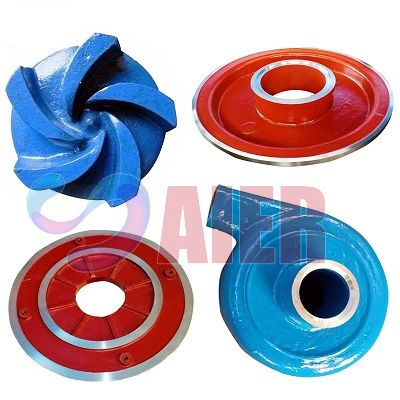Oct . 10, 2025 11:35 Back to list
China slurry pump wet end parts—wear-resistant OEM?
High-Chrome Wet Ends from China: What’s Real, What’s Hype
If you’re evaluating china slurry pump wet end parts, you’re probably juggling uptime targets, abrasive ore, and a maintenance crew that’s tired of midnight changeouts. I’ve spent enough time on plant floors to say this: materials science matters more than slogans. And yes, the newer high-chrome castings coming out of China have become surprisingly consistent—provided the foundry is disciplined.

Product snapshot: High Chromium Alloy Wet Ends (Origin: China)
The “High Chromium Alloy Wet Ends” set from Aier uses ASTM A532 Class III alloy (≈26–28% Cr) with heat-treatment aimed at HRC 58–64. In fact, the M7C3 carbide network is the hero here. Many customers say the life bump versus generic white iron is noticeable—less spalling, more predictable wear patterns.
| Spec | Value (≈, real-world may vary) |
|---|---|
| Material | ASTM A532 Cl. III (26–28% Cr), tempered |
| Hardness | HRC 60 ±2 (mapped across volute/impeller) |
| Compatible ranges | Common AH-type sizes 4/3–12/10; impellers ≈250–650 mm |
| Max slurry SG | ≈1.8; solids up to ≈45 wt% |
| pH / Temperature | pH 2–12; up to ≈120°C (with suitable seals) |
| Standards & tests | ASTM A532, ISO 9906 perf., ISO 1940-1 balance G6.3, ASTM G65 abrasion |
Process flow (how it’s actually made)
- Charge design and melt in medium-frequency induction furnace; on-heat spectrometer control (Cr, C, Mo, Nb).
- Resin-sand or lost-foam casting for smooth surfaces; riser/feeder simulation to curb shrinkage.
- Heat treatment: austenitize, quench, temper—target HRC 60; microstructure verified by metallography.
- Machining with CMM inspection; impeller dynamic balance to ISO 1940-1 G6.3.
- NDT: UT/MT, hardness mapping, dimensional 3D scan; hydro checks as required.
- Test coupons per heat; EN 10204 3.1 material certs available.
Where they run best
Mining and mineral processing (Cu, Fe, Au tailings), sand & gravel, dredging, coal prep, FGD slurries, and, occasionally, battery minerals. To be honest, rubber still wins in fine, sharp silica at certain pH, but china slurry pump wet end parts in high-chrome shine with coarse, high-impact slurries.
Real test data and service life
Lab abrasion (ASTM G65 Proc. A) came in at ≈82 mm³ volume loss—solid for this class. In field trials:
- Copper concentrate, SG 1.65, 30–35% solids: impeller life moved from ≈620 h to ≈1,050 h (+69%).
- Dredging sand, D50 ≈0.9 mm: volute replacement interval improved from 10 to 16 weeks.
One superintendent joked, “we’re arguing about hose clamps again, not impellers”—which is a good problem to have.
Vendor comparison (quick reality check)
| Vendor | Alloy & Hardness | QC / Certs | Lead Time | Warranty | Price Index |
|---|---|---|---|---|---|
| Aier Pumps (China) | ASTM A532; HRC 60±2 | ISO 9001; EN 10204 3.1; G65 data | 3–6 weeks (stock-dependent) | 12 months workmanship | 100 |
| Global OEM | Proprietary high-chrome; HRC 59–63 | ISO/API; full test dossiers | 8–14 weeks | 12–18 months | 160–220 |
| No-name Supplier | Variable white iron; HRC 52–60 | Limited paperwork | 2–4 weeks | 6 months (limited) | 70–85 |
Customization that actually helps
Options include thicker cutwater, modified vane count for duty points, surface hardfacing at impact zones, and profile tweaks to reduce NPSH issues. Interchangeability with common AH-style housings is available, but fit checks and tolerance mapping are wise. For china slurry pump wet end parts, ask for hardness maps and G65 data per batch—simple, powerful filter.
Two quick case notes
- Inner Mongolia iron ore: downtime per quarter dropped from 42 h to 19 h after swapping to high-chrome impellers/liners; power draw unchanged.
- SE Asia FGD line: pH swings 4–6; liner life +35% after heat-treatment tweak and tighter balance spec.
Bottom line: with credible QA and honest data, china slurry pump wet end parts can deliver OEM-level stability at a friendlier cost. Just don’t skip the paperwork.
Authoritative citations
- ASTM A532/A532M: Standard Specification for Abrasion-Resistant Cast Irons.
- ASTM G65: Standard Test Method for Measuring Abrasion Using the Dry Sand/Rubber Wheel Apparatus.
- ISO 9906: Rotodynamic pumps — Hydraulic performance acceptance tests.
- ISO 1940-1: Mechanical vibration — Balance quality requirements for rotors (G6.3).
- ISO 9001: Quality Management Systems — Requirements.
-
Reliable FGD Pump Manufacturer China | Durable & Cost-effective Solutions
NewsNov.23,2025
-
Reliable fgd Pump Manufacturer Solutions for Emission Control | Aier Pumps
NewsNov.23,2025
-
Explore Advanced FGD Pump Factory Solutions for Cleaner Power Plants
NewsNov.22,2025
-
Reliable & Efficient FGD Pump Chinese Supplier for Cleaner Energy Solutions
NewsNov.22,2025
-
Reliable China FGD Pump Suppliers for Effective Flue Gas Desulfurization | AiEr Pumps
NewsNov.22,2025
-
China FGD Pump: Durable & Efficient Solutions for Emission Control
NewsNov.21,2025
